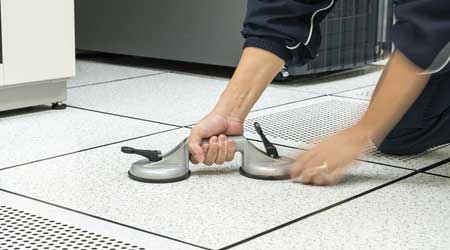Air-Flow Management Strategies for Data Centers
Monitor IT loads in each cold aisle and adjust air flow delivered into the cold aisle to deliver an appropriate amount of cooling air for the load in that aisle.
Imagine a computer room or data center that was built before or shortly after the turn of the century, conceptualized without containment, and designed to a long-since abandoned practice of maintaining “meat-locker” conditions — a data center that never broke the barrier of 500 kW of IT load.
Most facility managers, if they’ve been involved with data centers at all, have seen such a place, and not at the turn of the century, but rather recently. Anecdotal evidence suggests that these “forgotten” computer rooms (or data centers) may have more installed IT capacity than all the hyperscale, super-efficient, highly publicized data centers combined. Whether this assumption is true or not, what we as an industry do know is that the opportunity to improve our nation’s data center efficiency remains a vast untouched resource.
Over the last 10 years, the data center industry has educated designers, operators, and managers on how to fix these inherent inefficiencies. As a result, facility managers now have many low- or no-cost ways to reduce energy use in the data center. (See below.) Most of these measures are well known. But facility managers may not be aware of one other very effective energy efficiency step that counts as low-hanging fruit and that is rarely addressed. That energy-conservation measure is an air-flow management strategy that can be summarized in two simple steps:
- Monitor IT loads in each cold aisle.
- Adjust the air flow delivered into the cold aisle to deliver an appropriate amount of cooling air for the load in that aisle.
There are many data centers that have been meticulously maintained over the years, yet they do not have an air flow management strategy to mitigate the results of recirculation and bypass, which ultimately translate to hot spots, reduced system capacity, and wasted energy.
The air-flow items listed below do not qualify as an air-flow management strategy, per se; those energy-conservation measures need to be made in support of an air-flow management strategy.
Low-hanging fruit and beyond
Most data centers are filled with low-hanging fruit — energy-conservation measures that require little to no capital investment, and thus provide the best return on investment. These include:
- Create hot aisle-cold aisle configurations.
- Place blanking panels in unused slots inside IT equipment cabinets.
- Seal gaps between adjacent cabinets.
- Remove perforated floor tiles from hot aisles.
- Turn off unused computer room air conditioning units.
- Turn off and remove comatose servers.
- Seal gaps in raised floor openings.
- Raise the supply air temperature.
- Raise the chilled water temperature (where chilled water is used)
These measures are pretty much self-explanatory, and there have been numerous articles and presentations on why and how to implement them. There are many other system improvements, but these usually require larger investment. These may include energy-conservation measures such as:
- Adding variable frequency drives to motors.
- Installing containment to separate hot and cold aisles.
- Incorporating economizers.
- Modifying and optimizing control strategies.
- Replacing end-of-life equipment with more efficient selections.
These energy -conservation measures should be evaluated based on their total cost of ownership. Unfortunately, the decision to implement an energy conservation measure is not driven just by cost — in mission critical applications, the risk to the uptime of the critical IT, which may very likely support all the business operations of an enterprise, is a major consideration. Many energy efficiency projects that could provide good returns are killed for this very reason. Under these circumstances, it may be easier to phase out an aging data center and replace it with a newly designed and constructed facility. This is a long, expensive, and possibly even risky venture. The longer this approach can be delayed, the better an enterprise is able to utilize its available resources to the maximum extent.
The best way to optimize the available resources is to implement the low-hanging fruit measures. The good news is that these low- or no-cost energy-conservation measures can often be implemented with minimal risk to the facility’s uptime. Just as importantly, the payback for these steps can be measured in weeks or months rather than in years.
Vali Sorell (vsorell@glumac.com) is vice president and chief mission critical mechanical engineer at Glumac. He has 35 years of design experience, the last 20 of which have been dedicated to mission critical projects.
Related Topics:














